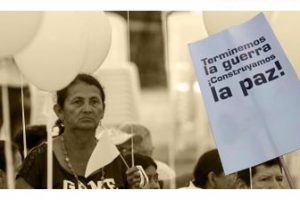. . DEMOCRATIC PARTICIPATION . .
An article by Antonio Madariaga Reales, Executive Director, Corporación Viva la Ciudadanía (translated by CPNN)
Hope returns, uncertainty diminishes and peacemaking is becoming possible. That is the first result of the hectic week in which the final peace agreement was endorsed in exhausting parliamentary sessions, in Tuesday in the Senate and Wednesday in the House. On Thursday the process began that must lead to the transfer in the veredales zones and points of normalization by the members of the Farc-EP, including the abandonment of their weapons It is called D-day: on Friday the Commission of Follow-up, Impulse and Verification of the Implementation of the Agreement was installed.

What is clear then is that we have to think of the most democratic and efficient way of implementing the agreements. In this regard, the first thing that appears on the horizon is the need to think about territorial peace. We must give content to that expression, coined by Sergio Jaramillo and today common place in the debate about the peace accords.
Territorial peace requires the design, implementation and monitoring of public policies, with citizen participation. It means a human rights approach, institutional means to execute the policy, some plans and budgets to develop it and transparency which implies – of course – monitoring and social control.
It has to be concrete. The prioritization categories used by the Fundación Pares include local infrastructure: tertiary roads and river navigability, 24-hour lighting and sewage and aqueducts, immediate response on issues of local justice administration and rural security, alternative projects that allow control and mitigation of the effects of illegal economies, physical security and guarantee of participation for human rights defenders. Priorities include local social leaders and additional actions focusing on Unsatisfied Basic Needs (NBI), United Nations supervision of Farc-EP, and local capacities for development, poverty alleviation and humanitarian needs. Counting the municipalities where there will be veredales zones and points of normalization, we have the number of 297 municipalities that should be the priority and that are in, amazingly enough (!), 25 of the 32 departments . Hence the question: how to have national policies which recognize and allow regional diversity, and are implemented in the territories themselves?
(Article continued in the right column)
(Click here for the original version of this article in Spanish.
What is happening in Colombia, Is peace possible?
(Article continued from the left column)
To achieve all this, it is essential to map out and convene all relevant actors in the territory, from a transparent and efficient central state institution that develops actions aimed at the appropriation of the agreements by these actors. The actions must include dissemination and pedagogy and identify how they are put in the agreements, and from there their place and proposals in the implementation process. What is needed is that the national government and the president in particular take the decision to tour the country and deliver the New Agreement to all citizens. It is not sufficient just to have the act of the Teatro Colón.
It must be accompanied by a pact of transparency that establishes rules that make it possible for public monitoring of the process. This has been one of the elements most demanded by diverse groups of young people that have mobilized recently in defense of the peace accords.
In turn, it will be necessary to adapt existing institutional structures of these municipalities to incorporate participatory planning and budgeting as a method for their work.
If we add to this a battery of indicators of effective enjoyment of rights, as developed by the Constitutional Court from sentence T-025, we will have a powerful set of institutional and social tools for implementation.
There will be a need to qualify and extend citizen participation. As we said in a previous approach to this issue, what is at issue is to build and / or strengthen a Social and Democratic State at all levels of national life and in all corners of the country. This requires a strong civil society, with high levels of organization and public involvement, that is to say, an active citizenship.
Let us not be naive. All this will be the flower of a single day if the Democratic Center cannot continue to hold majorities in the national congress, departments and municipalities, as well as the Presidency in 2018. If we are not to lose the peace process,, we will have to defend it at the voting booth.
(Thank you to Amada Benavides, the CPNN reporter for this article)